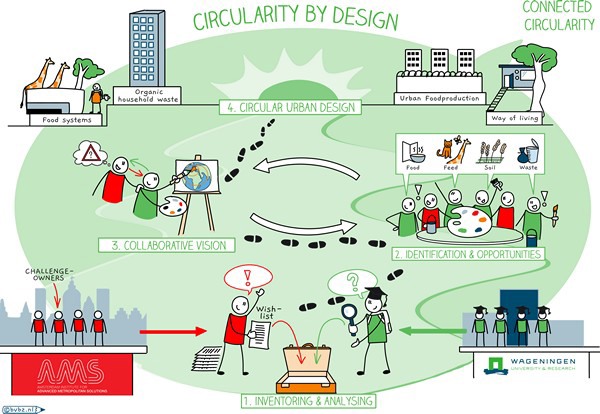Hilke Bos-Brouwers has worked on the recently finalised, EU funded Horizon 2020 REFRESH project, where 26 partners from 12 EU countries and China were working together to support UN SDG 12.3: halving the amount of food waste per person by 2030, across the full supply chain from farm to fork. The complexity lies much deeper than an individual’s purchases and use: to achieve this, the complete supply chain has to consider where product losses and waste occur. Then, opportunities arise how and where value can be created from any residual flows, as well as an increase in the reuse of recyclable materials like packaging.
Circularity by design
Hilke leads the Wageningen UR investment ‘flagship’ project Circularity by Design. This project develops a framework approach that takes into account the full activities that make up the use of food and other biomass services. One needs to consider the complete picture: requirements for food, animal feed, bio based materials, composting or soil fertilisation, etc. and take these into account within an original design from the start. How to make the best use of resources should be planned into the story up front as it cannot be successful if it is added as an afterthought.

Bottom-up... but not just nuts & bolts
Take, for example, a high rise building in a major city where people are living and working. There is both input and output: people eat and shop and they will create waste. The challenge is to design such buildings in a way to provide that community with healthy, nutritious food and deal with the leftovers. Currently, many high rise buildings have pretty simple waste management solutions: everything goes into one bag. The problem is that then you can’t do anything with that other than burn it. What you could do instead is to design the building in such a way that you separate the different waste streams for reuse and create value from any high value residual waste.
Zero waste catering
Circularity by Design is using a multi-stakeholder approach. It is also adaptive: it does not just provide the clients with the nuts and bolts, but with the conceptual design to build on. At a foundation in Amsterdam city centre, people are thinking about sustainable, waste free catering. One of the ideas was to utilise the refuge from the restaurant for animal feed, while at the same time developing an educational function for visitors and the surrounding neighbourhood. They will collaborate with Wageningen UR to apply the Circularity by Design approach for their ‘case’. We will not focus on mere technological solutions, but instead focus on the larger picture of how to source and offer food services. This involves answering questions such as: what menu choices could they make? How to source the food? How to deal with providing educational/information mechanisms? What criteria to use within a tender process for a new caterer? Etc.
The challenges
There is no shortage of ideas, many solutions are possible and there are many new inventions. But, the proof of the pudding is always in the eating: something that works. You need to start with the right building blocks, the right commitment, you have to pay attention to the social needs, guide the process, etc. You see time and time again that the creative process itself is not the problem.
Quite frequently the main challenge is to break through habits and existing customs, i.e. sticking to what you already know. In the field of Circularity by Design, it is people’s own agendas that need to be addressed as well: convincing them that they are both part of the problem and therefore central to the solution. Get them to see that resistance to change is natural and that they need a mindset change to achieve this – a really human issue.
Joining the dots
When developing solutions, it is necessary to consider how the people involved will perceive and appreciate them. Will they appeal to the needs and expectations of the stakeholders that have to apply it – rather than simply being a very futuristic prototype? It has to be realistic. Out-of-the-box thinking might deliver great new concepts, but these will need to withstand real world practical problems, such as budget and implementation to become applied in practice.
For example, where food preparation is concerned, food safety aspects are as important as health and sustainability. To safeguard us, authorities have imposed many regulations over time, of which some limit the array of circular solutions. If anything, don’t just focus on the low hanging fruit: looking over your own shadow and delving deep into the fundamentals of the issues at hand can lead to the best, even unsuspected ideas.
From the circularity by design perspective, solutions are designed ‘bottom-up’, and include closed loop, circular concepts. When applied to a large metropolitan area, it is also about the effect of a solution on others, for example nearby neighbourhoods, rural regions or at national level. Achieving 100% circularity is difficult, but at the very least it should be prevented that the choices on one level impede the implementation of solutions in another.
Resources
For more information: WUR Urban Greenhouse Challenge
WUR Urban Greenhouse Challenge
studentchallenges@wur.nl
urbangreenhousechallenge.nl
